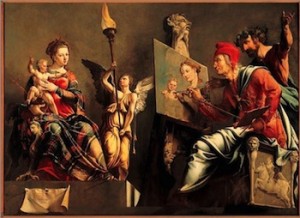 With his 1692 treatise The Big World Painted Small, Willem Beurs published the first manual on how to paint with oil and dedicated it to
With his 1692 treatise The Big World Painted Small, Willem Beurs published the first manual on how to paint with oil and dedicated it to
his four female pupils. Apart from describing how to paint, the manual touches upon recent scientific developments in biology and physics and references Greek and Chinese art, thus suggesting that Beurs expected his readership to perceive painting as part of a wider cultural
framework. The treatise opened up the secluded transfer of specialized artistic knowledge, made it available to a wider crowd and anticipated eighteenth-century’s strategies of public instruction and education; including Dutch adaptions of Diderot’s Encyclopédie.
As a consequence of the recent focus on objects and materials, current art historical discourses now turn to investigate the mediation ofknowledge between things and humans, putting education forth as an important and understudied research subject in the discipline. This NKJ volume aims to investigate the relation between the visual arts (painting, drawing, applied arts, architecture, sculpture, photography) and education by employing a twofold approach: On the one hand it asks how the visual arts were taught: to whom (i.e. to experts, amateurs, women, children), why (skill, general development, entertainment, literacy, religious and/or scientific andmedical education) and how (i.e. in classes, hands-on, through manuals, illustrations, models, photographs, radio, television)?
On the other hand it investigates how the visual arts themselves were employed in education and through which processes and media they became effective. How were paintings, drawings, calligraphy, prints, models, photographs etc. used in scientific and professional training?
How did the visual arts actively participate in the emerging culture of education and informed educational reforms to move from a text-based culture to the inclusion of images and objects?
This volume wants to trace these developments in the Netherlands and in Netherlandish art over a long timespan.
Subjects can include (but are not limited to):
drawing classes, emergence of the academies, anatomy teaching;
art manuals and art history for amateurs and art lovers;
teaching applied arts and architecture;
teaching material knowledge and acquiring material literacy;
iconographies of teaching and learning in the visual arts;
teaching with pictures, objects, cabinets, models, photo, film;
illustrations of educational works, publishers of art education;
educational ideals and religious thought;
images and art in religious education (i.e. the book of nature);
reception of educational reform movements (e.g. Comenius, Pestalozzi, Fröbel, Montessori, Bauhaus);
art history curricula at the universities, art education in museums;
The NKJ is dedicated to a particular theme each year and promotes innovative scholarship and articles that employ a diversity of
approaches to the study of Netherlandish art in its wider context. For more information, see
Contributions to the NKJ (in Dutch, English, German or French) are limited to a maximum of 7,500 words, excluding notes and bibliography. Following a peer review process and receipt of the complete text, the editorial board will make final decisions on the acceptance of papers.
Please send 500-word proposals and a short CV to all three volume-editors by December 8, 2016.
Eric Jorink: eric.jorink@huygens.knaw.nl
Ann-Sophie Lehmann: a.s.lehmann@rug.nl
Bart Ramakers: b.a.m.ramakers@rug.nl
Schedule:
8 December 2016: Deadline for submission of proposals.
January 2017: Notifications about proposals.
15 June 2017: Deadline for submission of first drafts.
August 2017: Comments to contributors.
December 2017: Final drafts.
Spring 2018: Copy-editing, print proofs for correction.
Winter 2018: Publication.
Lessons in Art. Art, Education, and Modes of Instruction since 1400.
NKJ (Netherlands Yearbook for History of Art) 68, 2018

Leave a Reply
You must be logged in to post a comment.